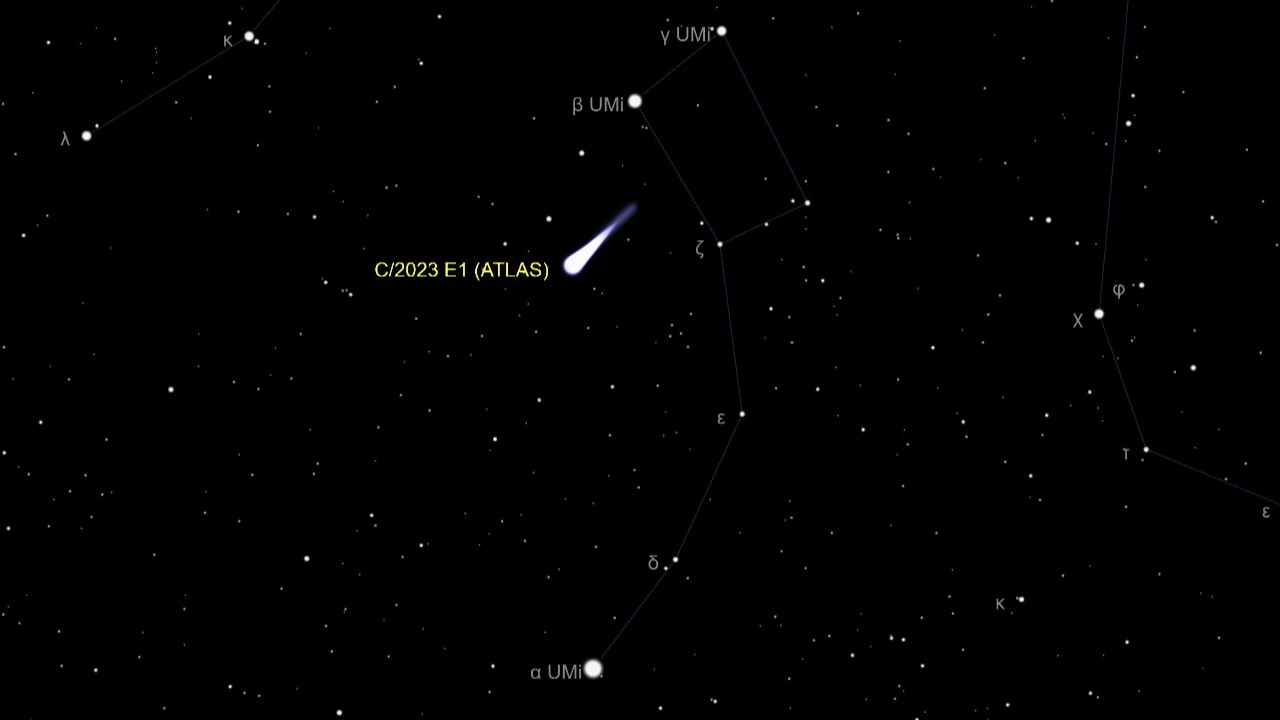How to see comet E1 ATLAS high in the night sky in July near the Little Dipper
While not particularly bright, the comet will be fairly easy to spot for Northern Hemisphere skywatchers.

A relatively newly discovered comet makes for a tantalizing skywatching target this summer.
Comet C/2023 E1 ATLAS was discovered in March 2023 by the Asteroid Terrestrial-Impact Last Alert System (ATLAS), which is funded by NASA and operated by the University of Hawaii. This array of four telescopes spread out in Hawaii, Chile and South Africa scans the sky for near-Earth objects in order to warn of any potential hazards heading Earth's way.
While not particularly bright, the comet will be fairly easy to spot for Northern Hemisphere skywatchers, high in the skies throughout the summer near Ursa Minor, the Little Dipper. Comet E1 ATLAS reaches perihelion, its closest point to the sun, on July 1.
Related: Comets: Everything you need to know about the 'dirty snowballs' of space

Looking for a telescope to see comets or anything else in the night sky? We recommend the Celestron Astro Fi 102 as the top pick in our best beginner's telescope guide.
By the time July's new moon arrives on July 17, the comet will be approaching its maximum brightness and will have moved eastward toward the constellation Cetus, the Whale. If you go looking for the comet yourself, don't expect to see a bright green snowball with a well-pronounced tail; through most backyard optics, the comet will likely appear as a hazy, greenish smudge.
When comet C/2023 E1 (ATLAS) was discovered, it was quite faint at just magnitude +19 (the lower the magnitude, the brighter the object). It has since brightened to around magnitude +10, enough to be spotted with binoculars and most medium-sized telescopes, but still too dim to be seen with the unaided eye. The comet is expected to reach a maximum magnitude of +8 or +9, still fairly dim compared to many other night sky sights.
Nevertheless, comet C/2023 E1 (ATLAS) has proven photogenic to patient astrophotographers. Austria-based comet hunter and astrophotographer Michael Jäger has imaged C/2023 E1 (ATLAS) on multiple occasions, and has been able to capture its somewhat dim tail:
Get the Space.com Newsletter
Breaking space news, the latest updates on rocket launches, skywatching events and more!
Comet C/2023 E1 (ATLAS) 2023 june 15 22.20 UT LRGB 1300/240/240/240sec 12"/4 Moravian G3-16200 2x2bin Michael Jäger pic.twitter.com/Dc3J5MsPxLJune 16, 2023
In a 100-minute exposure taken on June 18, Jäger captured an image that shows the comet's motion relative to the background behind it.
Comet C/2023 E1 (ATLAS) 2023 june 18 22.30 UT 100min 14"/4.2 QHY600 Michael Jäger pic.twitter.com/n0aHYa7Lx4June 19, 2023
Astrophotographer and astronomy educator Dave Eagle caught an image of the comet on June 26 from Raunds, England.
Another comet is visible, this time in Ursa Minor.This is Comet C/2023 E1 (ATLAS) taken early this morning.A very faint tail is visible in the original image.Another almost all-nighter, and a busy day, so fuzzy-headed, tired and forgot the date. Now corrected. 🤣 pic.twitter.com/B17N1hYkiAJune 26, 2023
And comet hunter and amateur astronomer Taras Prystavski imaged the comet from the Great Basin Desert in Utah on June 23, showing the comet's characteristic green glow in clear detail.
Comet C/2023 E1 (ATLAS)2023 Jun. 23.23 UT Dia.=&10.2' Tail=&25' in PA 119 deg... [T68] 0.28-m f/2.2 RASA astrograph + CMOS... iTelescope observatory, U94 (remotely from Great Basin Desert, Beryl Junction, Utah, USA) pic.twitter.com/rlIkbHZJFTJune 24, 2023
Want to see comet C/2023 E1 (ATLAS) or capture stunning your own images of comets and other objects in the night sky? Our guides on the best telescopes and best binoculars will help.
Learning about the best cameras for astrophotography and best lenses for astrophotography will also help capture incredible deep-sky sights.
Editor's Note: If you snap your own photos of comet C/2023 E1 (ATLAS) and would like to share them with Space.com's readers, send your photo(s), comments, and your name and location to spacephotos@space.com.
Join our Space Forums to keep talking space on the latest missions, night sky and more! And if you have a news tip, correction or comment, let us know at: community@space.com.

Brett is curious about emerging aerospace technologies, alternative launch concepts, military space developments and uncrewed aircraft systems. Brett's work has appeared on Scientific American, The War Zone, Popular Science, the History Channel, Science Discovery and more. Brett has English degrees from Clemson University and the University of North Carolina at Charlotte. In his free time, Brett enjoys skywatching throughout the dark skies of the Appalachian mountains.
-
STARPUNK Reply
Great news Even better since it should be visible all night long like Comet Hyakutake was in 1996. Now if we can just have all the Canadian forest fire smoke and haze clear away.Admin said:A comet discovered just months ago will make for an easy-to-spot, if somewhat dim, target for summer skywatchers eager to see a snowball streak through the solar system.
How to see comet E1 ATLAS high in the night sky in July near the Little Dipper : Read more -
STARPUNK Saw it once about 2 weeks ago. It looked like a smudge that should not have been there. It was easy to locate, near Ursa Minor. The location helped a LOT.Reply









